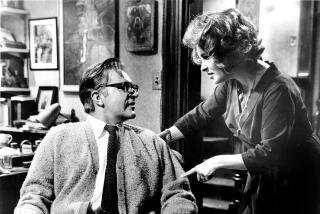BOOK REVIEW: MEMOIR : A Uniquely Told Tale of Love and True Grit : MAGGIE: A Love Story <i> by John Sanford</i> , Barricade Books, $22, 415 pages
- Share via
This book is a master class in love, the chronicle of the author’s 50 years of marriage to the screenwriter Marguerite Roberts.
You could ransack an entire library without learning as much about commitment, mutual respect, delight, devotion and resilience as you’ll find in these succinct pages.
The story is told in some of the most distinctive prose written in this century, so individual in structure, cadence and vocabulary as to be not only immediately recognizable but virtually inimitable.
A trove of private memories, perceptions, insights and incidents is punctuated by brief portraits of public figures and equally terse accounts of pivotal events. Here, as in many of his previous books, John Sanford uses these vignettes as a frame to provide “the color of the air”--the particular mood of a year, a decade or an entire era.
Entirely different in tone from the intimate style of the personal narrative, these miniature essays are searingly intense, fueled by the author’s lifelong concern with social injustice and political immorality. The language in these segments is of another order entirely: impassioned and so highly figurative that you’re reminded of the 17th-Century metaphysical poets.
Set against conversational accounts of daily life in Encino, Santa Barbara and Carmel; trips up and down the California coast, and journeys to Europe, the vignettes create the verbal equivalent of a painter’s chiaroscuro, producing the same arresting contrast of light against dark.
The Sanfords’ tranquil and productive literary life was shattered in 1951, when both received subpoenas to appear before the House Committee on Un-American Activities.
Maggie Roberts stoically refused to betray friends and acquaintances. She was blacklisted, and her long and happy association with Metro-Goldwyn-Mayer came to a sudden end. Some testimony from the hearings is included here, interwoven with the author’s pierc-ing memories of Roberts’ quiet anguish at being deprived of the work she loved, misery compounded by Sanford’s acute sense of responsibility in the matter.
Essentially apolitical, Roberts had joined the Communist Party
for an absurdly brief period, an almost inadvertent act that would blight the entire following decade. Documented at length in an earlier book, “A Walk in the Fire,” this bleak period is condensed to the essentials here.
With the emphasis kept on the personal ramifications of the blacklist for Roberts and John Sanford, the episode is particularly wrenching. By this point in the book, Roberts has totally captivated the reader. Already charmed by her unfailing good nature and vivacity, we’re awed by her courage and her adamant refusal to blame her husband for her predicament.
After 10 dreary years, Roberts was asked to write films again, first for Columbia and then for Paramount. In 1969, she won both the Christopher and the Western Heritage awards for “True Grit,” and John Wayne, sensible enough to put art before politics, received his only Oscar for his role in what he called “the best screenplay I ever read.”
Buoyed by Roberts’ renewed happiness, Sanford wrote a remarkable quartet of historical books, each composed entirely in the vignette style he perfected and continued to use judiciously in the five volumes of autobiography that followed--books in which a private life is placed within the context of the public events that formed his strong convictions.
Although “Maggie: A Love Story” is similar in structure, here the emphasis shifts away from the writer to the woman who illuminated his life for more than half a century. Instead of referring to himself in the first person, Sanford uses the second, a stylistic device assuring Roberts the place at center stage she held for the entire drama of the marriage, a place she earned on the day they met in 1936, deserved for more than half a century and still keeps.
This book guarantees that readers will understand precisely why.
“I hate to see you leave a room,” Sanford often said, but in February 1989, “she’d left it for good and all, and the room now was empty--and the room of the world as well.”
This tender and affectionate tribute begins to refurnish that space.
More to Read
Sign up for our Book Club newsletter
Get the latest news, events and more from the Los Angeles Times Book Club, and help us get L.A. reading and talking.
You may occasionally receive promotional content from the Los Angeles Times.







